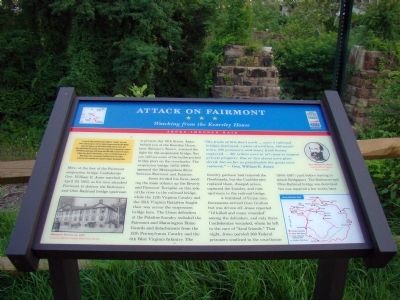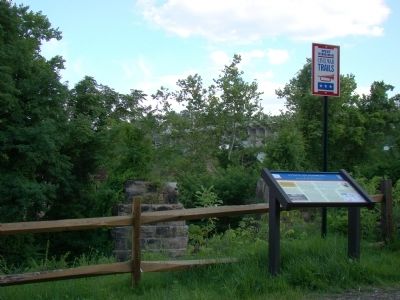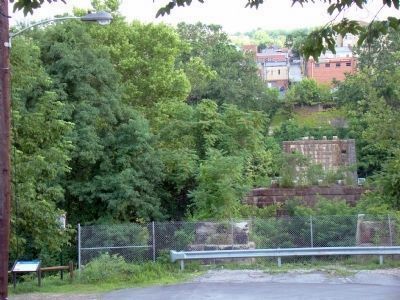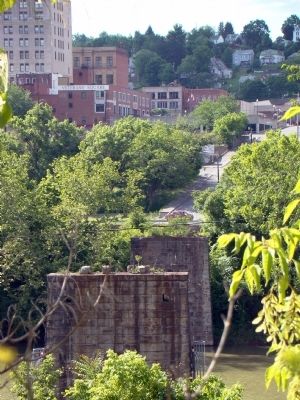Fairmont in Marion County, West Virginia — The American South (Appalachia)
Attack on Fairmont
Watching from the Kearsley House
— Jones-Imboden Raid —
(Preface):On April 20, 1863, Confederate Gens. William E. “Grumble” Jones and John D. Imboden began a raid from Virginia through present-day West Virginia against the Baltimore and Ohio Railroad. Taking separate routes, they later reported that they marched 1,100 miles, fought several engagements, captured 100 Federals, seized about 1,200 horses and 4,000 cattle, and burned 4 turnpike bridges, more than 20 railroad bridges, 2 trains, and 150,000 barrels of oil. Most bridges were soon repaired. Confederate losses were slight. By May 26, both commands had returned to Virginia’s Shenandoah Valley.
Here, at the foot of the Fairmont suspension bridge, Confederate Gen. William E. Jones watched on April 29, 1863, as his men attacked Fairmont to destroy the Baltimore and Ohio Railroad bridge upstream at present-day 12th Street. Jones, behind you at the Kearsley House, later Skinner’s Tavern, watched the fight for the suspension bridge. You can still see some of the bullet-pocked bridge piers on the riverbanks. The suspension bridge (1852–1908) spanned the Monongahela River between Fairmont and Palatine.
Jones divided his force, sending the main column up the Beverly and Fairmont Turnpike on this side of the river to the railroad bridge, while the 12th Virginia Cavalry and the 35th Virginia Battalion fought their way across the suspension bridge here. The Union defenders at the Palatine foundry included the Fairmont and Mannington Home Guards and detachments from the 13th Pennsylvania Cavalry and the 6th West Virginia Infantry. The foundry garrison had removed the floorboards, but the Confederates replaced them, charged across, captured the foundry, and rode upstream to the railroad bridge.
A trainload of Union reinforcements arrived from Grafton but was driven off. Jones reported “12 killed and many wounded” among the defenders, and only three Confederates wounded, whom he left in the care of “kind friends.” That night, Jones paroled 260 Federal prisoners confined in the courthouse (1844–1897) yard before leaving to attack Bridgeport. The Baltimore and Ohio Railroad bridge was destroyed but was repaired a few weeks later.
“The fruits of this day’s work . .. were 4 railroad bridges destroyed, 1 piece of artillery, 300 small-arms, 260 prisoners, and many fresh horses captured. . . . My orders were in all cases to respect private property. One or two stores were plundered, but as far as practicable the goods were restored.” —Gen. William E. Jones
Erected by West Virginia Civil War Trails.
Topics and series. This historical marker is listed in this topic list: War, US Civil. In addition, it is included in the West Virginia Civil War Trails series list. A significant historical date for this entry is April 20, 1863.
Location. 39° 29.017′ N, 80° 8.417′ W. Marker is in Fairmont, West Virginia, in Marion County. Marker is at the intersection of Madison Street and Cleveland Avenue, on the left when traveling south on Madison Street. It is at the foot of Madison Street. Touch for map. Marker is in this post office area: Fairmont WV 26554, United States of America. Touch for directions.
Other nearby markers. At least 8 other markers are within walking distance of this marker. High-Level / Million Dollar Robert H. Mollohan Bridge (about 600 feet away, measured in a direct line); A. Brooks Fleming House (about 600 feet away); Veterans Memorial (about 600 feet away); Veterans Square (about 600 feet away); Marion County Veterans (about 600 feet away); Battle for the Bridge (about 700 feet away); Fairmont (approx. 0.2 miles away); a different marker also named Veterans Memorial (approx. 0.2 miles away). Touch for a list and map of all markers in Fairmont.
More about this marker. Marker has photograph of “Skinner’s Tavern ca. 1880” on the lower left, a portrait of General William E. Jones on the upper right, and a map of the Jones–Imboden Raid.
The “Battle for the Bridge” marker is on the opposite shore.
Also see . . .
Confederates Capture Fairmont. West Virginia Archives and History website entry:
1863 article in the Wheeling Daily Intelligencer. “Wednesday morning dawned wet and foggy; our scouts came dashing in and reported the enemy approaching only two or three miles off. One company of militia and most of the armed citizens went out on the hills to meet him. About eight o'clock picket firing commenced and was kept up briskly for half an hour. The enemy finding we were posted on the hills prepared to rake him severely as he came down the pike along Coal Run, sent a heavy force on the hills to drive us off. In this they succeeded after several of them had been summarily unhorsed. The men from the hills retreated, some to the main force, near the railroad bridge, a mile above town, and some to the Palatine end of the Suspension Bridge. The latter made a gallant stand and resisted the crossing for nearly an hour. They took shelter in a Foundry and fired from the windows upon the rebel sharpshooters, who dismounted and took positions in vacant houses, behind fences, stables and whatever else would conceal their cowardly carcass from our unerring aim. Thus was the unequal contest continued until one man, named Coffman, from Bingamon, was fatally wounded, and all but five or six had straggled off. The remainder ceased firing and each one took care of himself as best he
could. When the firing ceased the rebels sent over a flag of truce to demand a surrender, but to their astonishment they found no one to receive it. They then hastily replaced the plank which had been removed from the bridge, and crossed over to the number of nearly a thousand, and pushed on up to get in the rear of our men at the Railroad Bridge.” (Submitted on July 28, 2009.)
Credits. This page was last revised on January 29, 2022. It was originally submitted on July 28, 2009, by J. J. Prats of Powell, Ohio. This page has been viewed 2,211 times since then and 47 times this year. Photos: 1, 2, 3, 4. submitted on July 28, 2009, by J. J. Prats of Powell, Ohio.



